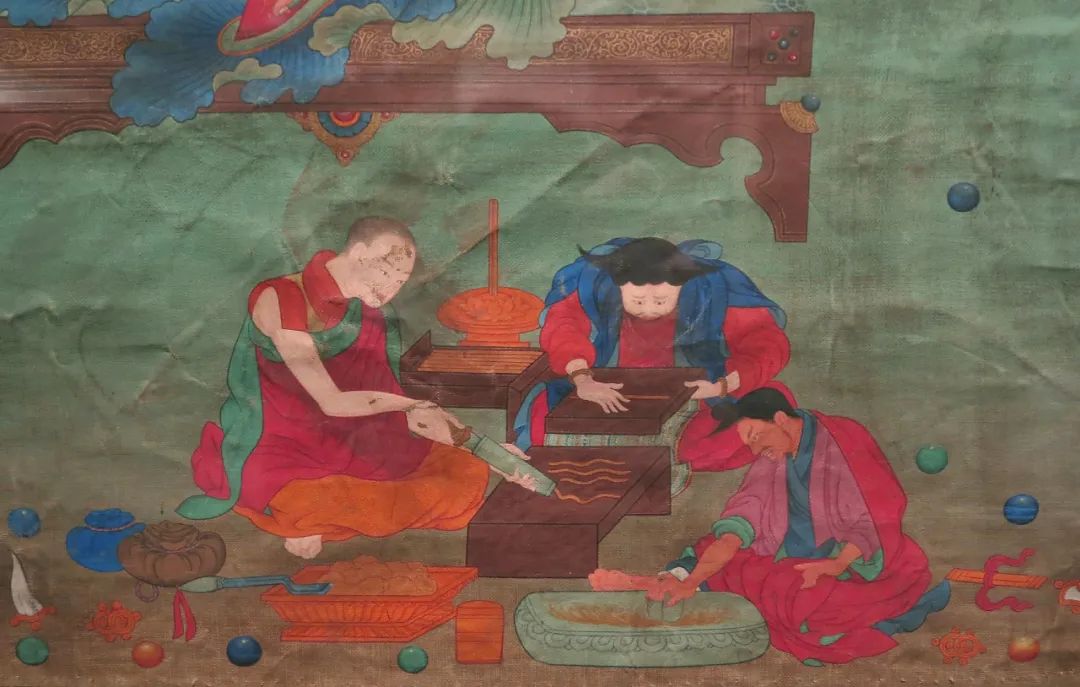
The scent lingers around us: the aroma of Tibetan incense culture in the highlands.
Unique Tibetan incense culture
Interested in our Tibetan incense?Can be purchased through this link
Traditional Derge Dsongzar Tibetan Incense Sticks

"Riding on a Lion, Vaisravana Heaven and his Attendant Followers"
Late 17th century, collection of the Rubin Museum
Detail: Monk donor holding bundles of incense and khata

"Wooden Auspicious Symbol Incense Mold" 19th century, Western Tibetan region.
Collection of Pitt Rivers Museum, University of Oxford.
There are over twenty types of molds mentioned in various scriptures.

"Metal Double Deer Dharmachakra Style Multi-use Incense Box"
From the first half of the 19th century, in the collection of the Zanabazar Fine Arts Museum in Mongolia.
This object is used to hold and burn thread-like incense, known as "pos gzhong" or "pos sgam" in Tibetan.
Combination incense burners from South Asia and East Asia are called "pos phor" or "pos sprok" in Tibetan.
Incense pouches used for carrying incense powder or stick incense are called "phyer pur ma" or "pos snod" in Tibetan.
People generally consider Nima County to be the birthplace of Tibetan incense and incense-making culture.
(Nima County is widely regarded as the homeland of Thumi Sangbu Zha.)
Burning incense is seen as a method of purification and creating a sacred space, while making incense is considered a unique practice of spiritual cultivation and offering.

《The Great Master Jigten Sumgon Offering Incense / འཇིག་རྟེན་གསུམ་མགོན་》
Late 15th century, private collection
Generally regarded as a pioneering work on incense-making in the Tibetan region
Related to offerings and incense-making practices.

"Mindrolling Trichen Dechar Rinpoche / གཏེར་བདག་གླིང་པ་"
18th century, Hahn Cultural Foundation Collection
Dechar Rinpoche's writings on incense burning and making
Presented to us the fervor of "Incense Culture" in the Central Tibetan region.

"The Eight Bodhisattvas: Ksitigarbha Bodhisattva"
Late 18th century, a mixed style artwork from the Kang region
Currently in the collection of the Rubin Museum
Detail: Monks and laypeople making incense sticks
This detail depicts at least seven steps of making incense sticks:
Gathering ingredients - Mixing - Grinding - Rolling - Shaping - Packaging - Testing the fragrance
We generally classify the incense burning methods in Tibetan areas into five categories based on their shapes:
- Line-shaped incense
- Pagoda-shaped incense
- Circular incense
- Powder incense
- Square incense
Among them, line-shaped incense and circular incense appeared relatively late.
Various types of incense containers and incense burners also show a "multi-source" characteristic, such as incense bowls from South Asia, combination incense burners from East Asia, tall hanging incense burners from Central Asia, and multi-functional incense boxes for placing line-shaped incense from the local region.
We can even explore the history of its dissemination in works of art.
Today, when studying the craft of making incense in Tibetan regions, we often refer to a comprehensive work known as the "Incense Making Guide" (སྤོས་སྦྱོར་ལག་ལེན་). One of the most comprehensive works on the subject comes from the eminent Tibetan lama Deuma Geshe (དེའུ་དམར་དགེ་བཤེས་བསྟན་འཛིན་ཕུན་ཚོགས། 1672-?) in his book "Detailed Explanation of Skilled Craftsmanship" (རིག་པ་བཟོ་ཡི་གནས་ཀྱི་ལས་ཚོགས་ཕྲན་ཚེགས།).
In this work, the process of making incense is divided into ten steps:
Selecting wood (such as cypress) - grinding the wood with water or burning it
Grinding the powder with other ingredients to form a paste
Shaping the paste into blocks and drying them
Mixing the block materials with other ingredients
Using a mold or tool to shape various types of incense
Drying the shaped incense a second time
Binding or reshaping the incense
Testing the incense.

"Gakhama Gachik School of Painting: The Twelve Venerable Disciples of the Buddha"
Late 18th century, from the private collection of the Rubin family
Detail: Smoke rises from the censer, revealing the Pure Land of the West.

"The Ninth Dalai Lama Lungtok Gyatso with Various Masters of the Gelug Tradition"
18th century, Private Collection
Detail: Attendant holding a tall hanging incense burner and a brocade incense bag

"The Shakyamuni Buddha and Various Elders Arhat"
19th century, from the collection of the TH Museum in New York
Detail: Pay attention to the incense bowl on the far right of the altar
These types of incense bowls from the collection are mostly of South Asian origin.
The craftsmen who produce incense sticks always adhere to their industry oath:
Authentic materials, flawless craftsmanship, selfless dedication.
During ancient times, there were specialized groups responsible for the transportation and trade of incense.
Incense was often traded as a commodity and used as a gift in East Asia and North Asia.
There are many poems and literary works describing the art of making incense that have been passed down through the Song, Yuan, Ming, and Qing dynasties.

"Metal-carved auspicious Vajra top cover incense burner"
15th century, Kang region craftsmanship, collection of Rubin Museum of Art
